What it's Really Like to Be A Dog Handler in the US Military
By: Ashley Bunch, June 1, 2017, Military Times (Photo Credit: Marine Corps)
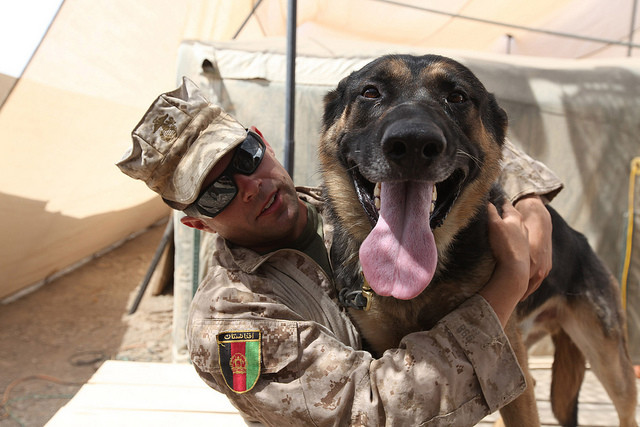
The public face of the military working dog community mostly comes from TV and movies, which feature these dogs with impeccable detection skills, incredible obedience and lightning speed.
But what it takes to get there isn’t always depicted on screen.
With “Megan Leavey,” the Hollywood version of a real-life story of a Marine Corps dog handler’s heroism, set to hit theaters June 9, Military Times reached out to several service members who work with military working dogs, or MWDs, to see what it’s like to be a handler in today’s military.
“It is very hard for handlers to watch movies about MWDs nowadays because we are always their biggest critics,” said Air Force Staff Sgt. Monica Rodriguez, who’s been a K-9 handler for four years. “As far as the mental and physical connection between the handlers and dogs, they are spot on. It is one of the most touching qualities about a dog team.
“The reports on the dog’s capabilities to find bombs or drugs are fairly modified due to obvious reasons, but it paints a good picture.”
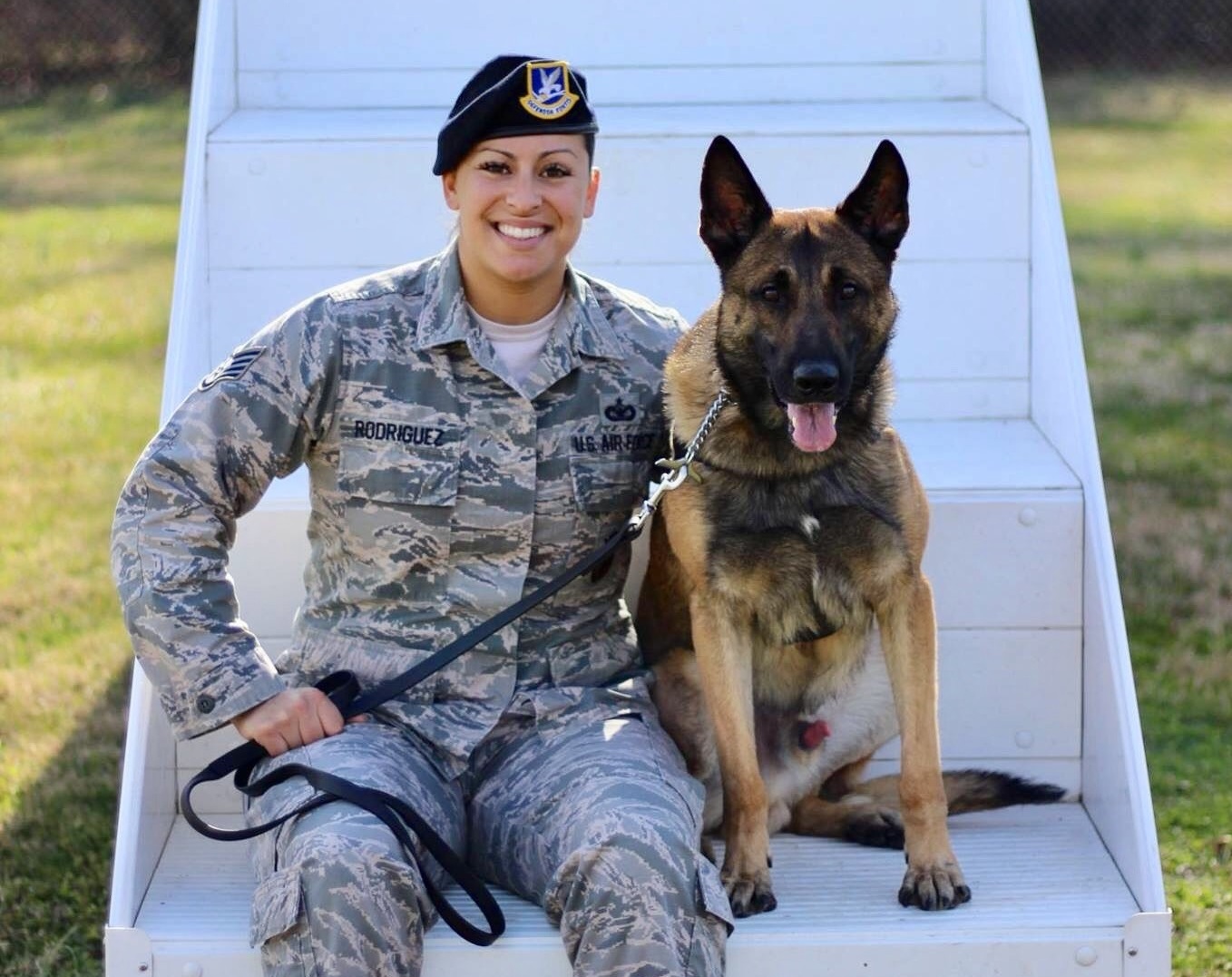
Staff Sgt. Monica Rodriguez poses with her military working dog, John.
Photo Credit: Courtesy of Monica Rodriguez
From fitness to post-traumatic stress to retirement, here’s some more of that picture, courtesy of MWD handlers who are in, or recently out of, uniform.
50 pounds, plus pup
“Being physically fit in Security Forces K-9 is a crucial part of our job, especially in deployed locations,” said Rodriguez, who is stationed at Joint Base Andrews, Maryland, and has performed 15 presidential protection missions. “We have to have the strength to get ourselves and our dogs out of harm’s way. We have to be able to lift our dogs as well as wear 50-plus pounds of gear.”
The dogs can weigh up to 100 pounds. And like their handlers, they have to stay in shape.
“We have to be informed of different ways the environment can affect our MWDs and be prepared to respond in any given situation to care for our MWD,” said Air Force Staff Sgt. Sara Lyons, a seven-year dog handler who works out five or six days a week while serving at Italy’s Aviano Air Base. “My MWD also gets a good amount of exercise during work by walking patrols and training.”
The fitness standards don’t change for male and female handlers — and neither does the weight of a 100-pound dog. That’s fine by the female handlers who were interviewed.
“As a female, especially in the military, you want to be treated as an equal,” said Heather Cortez, a former senior airman who handled dogs for four years in uniform and now works for a civilian K-9 company. “I've always been determined and independent, that is how I got to where I was in my career. No one helped me along the way or did my training or tests for me. I definitely had support over the years from family and friends, but everything that I accomplished up to that point in life I did on my own. And as a female you want your male counterparts to recognize that as well and treat you how they treat the guys.”
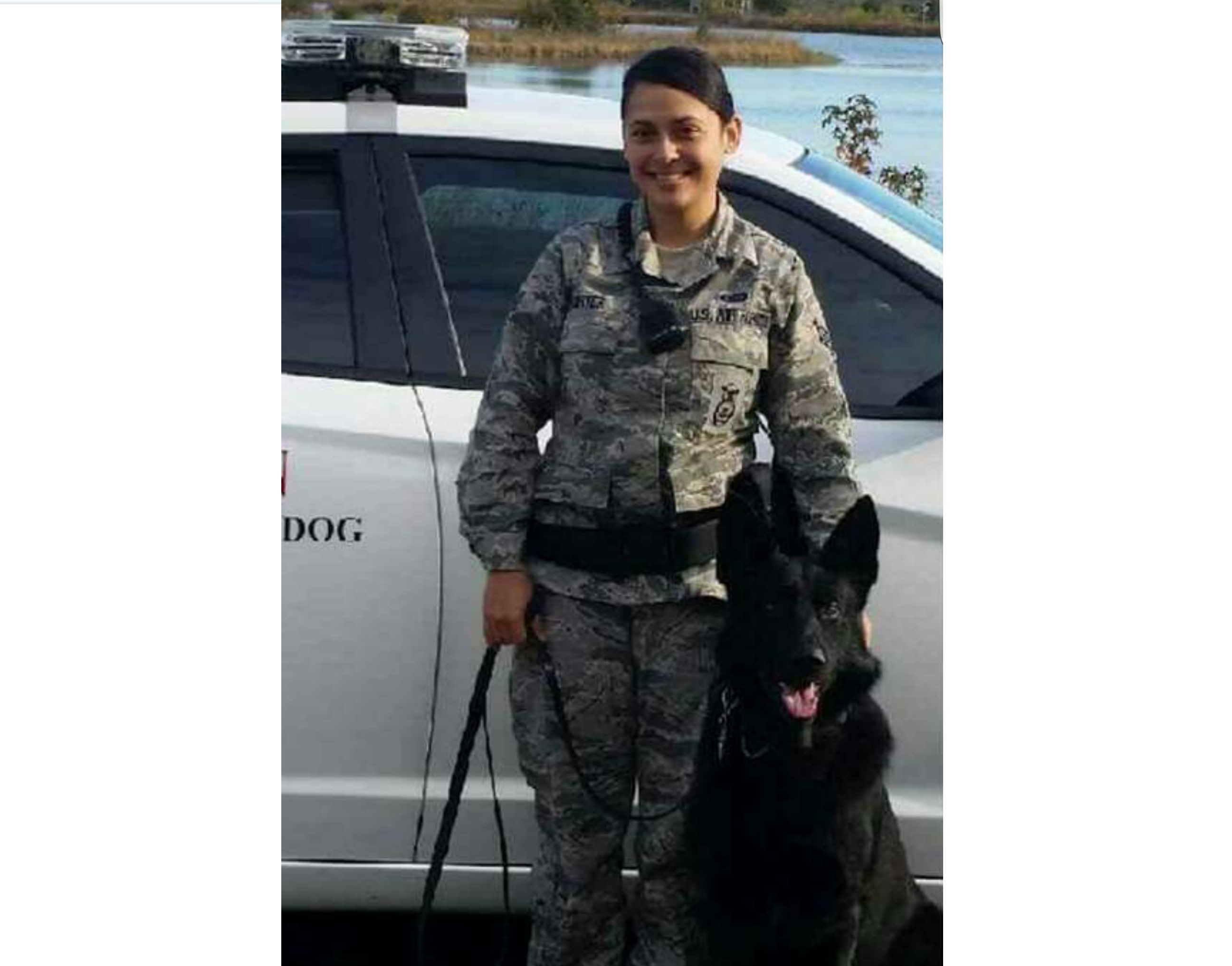
Then-Senior Airman Heather Cortez poses with her military working dog, Blecky. Cortez served as a military working dog handler for four years and now handles working dogs for a private-sector company.
Know your dog
Preparing for physical challenges may be critical to the job, but managing a dog’s stress level, and knowing its warning signs, can be just as important. The dogs are military assets and can’t be treated like children, the handlers said, but they can break down, and their will to work can suffer — or disappear altogether.
“These dogs are affected by stress and PTSD the same way we are,” Rodriguez said. “Some of us can't stand to hear the sound of an explosion or a back fire to a vehicle. It’s the same with them. Some dogs may shy away and some dogs may [be aggressive] toward the handler or someone else. You never know until you experience it with them.”
Prep work can involve exposing the dogs to “stressful scenarios to help them combat future situations that might cause stress,” said Air Force Tech. Sgt. William Stone, a kennel master at Joint Base Andrews. The dogs are put on a cycle that encourages “as much rest as possible,” Stone said, and veterinarians are on call when needed.
Despite the support network and advanced training methods, the basic challenge faced by handlers isn’t much different, at least on the surface, from any dog owner who’s tried to train their pooch.
“In my opinion, the most difficult part of the training process is not knowing what the dog is actually thinking,” Rodriguez said. “A simple task can take so long for the dog to learn, and for us humans it can get frustrating.”
However, the learning curve isn’t always bent toward the dogs.
“All handlers get the same training, but some are new to K-9,” Cortez explained. “Some dogs might be pretty advanced, but if their handler is new, they have to do baby steps along with them. That can also frustrate the dog because he or she may just feel like you are in their way.”
Saying goodbye
One common, but usually misstated, theme of MWD stories comes at the dog’s retirement. Often there is talk of reunion with a handler, but there’s rarely a mention about other handlers who worked with the dog at some point, and how they all want to take the dog home with them.
“A lot of reports will say an MWD got reunited with his or her handler, but what some people don't know is that dog has most likely had multiple handlers,” Cortez said. “It's kind of sad because you wait until the dog is able to retire, but in the end you most likely won't get to take the dog home with you because someone else will get the opportunity first.”
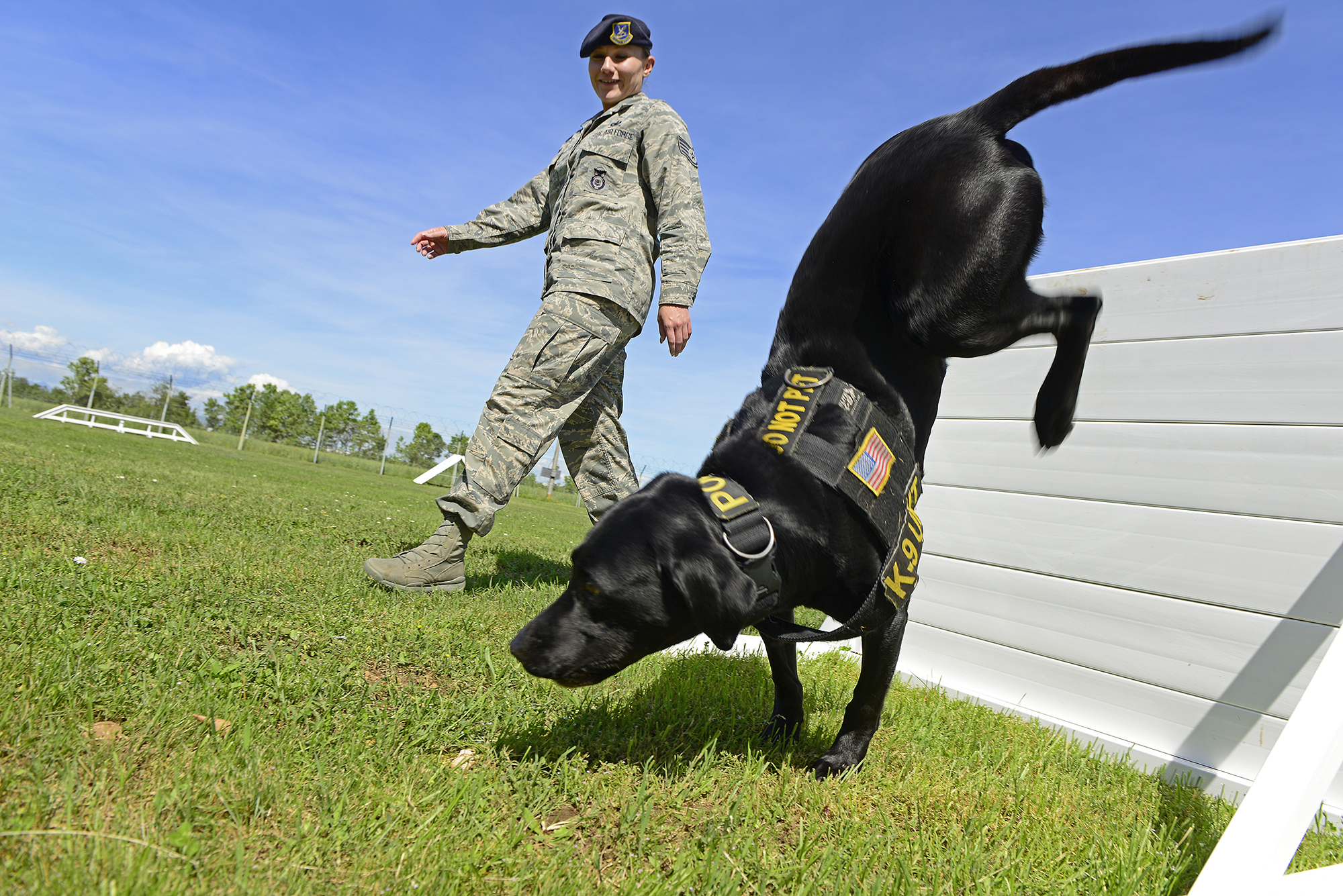
Staff Sgt. Sara Lyons, a military working dog handler with 31st Security Forces Squadron, takes her dog JD through an obstacle course May 16 at Aviano Air Base, Italy.
Photo Credit: Airman 1st Class Ryan Brooks/Air Force
It’s a particularly difficult part of a job where building a relationship with your partner is essential to the mission.
“The K-9 career field is a bond with an MWD that you won't ever forget,” Lyons said. “There will be challenging days, but they are all worth it.”
The other dog handlers interviewed had a similar message. As Rodriguez put it, “Our job consists of blood, sweat and tears, but that's what makes us a special breed. We are very passionate about our jobs and our partners because they are not only working dogs, they are family. We literally trust them with our life.”
From the start of the shift, Cortez said, “when you get your dog from the kennel, you make his or her whole day.” It creates a relationship that goes beyond the job, she said — though some things are better left at the office.
“I have two cats at home that I adore very much,” she said.
Silent Sentinels: Gate Guards, Our First Line of Defense
By A1C Breanna Carter, 90th Missile Wing Public Affairs, 4 May 2017
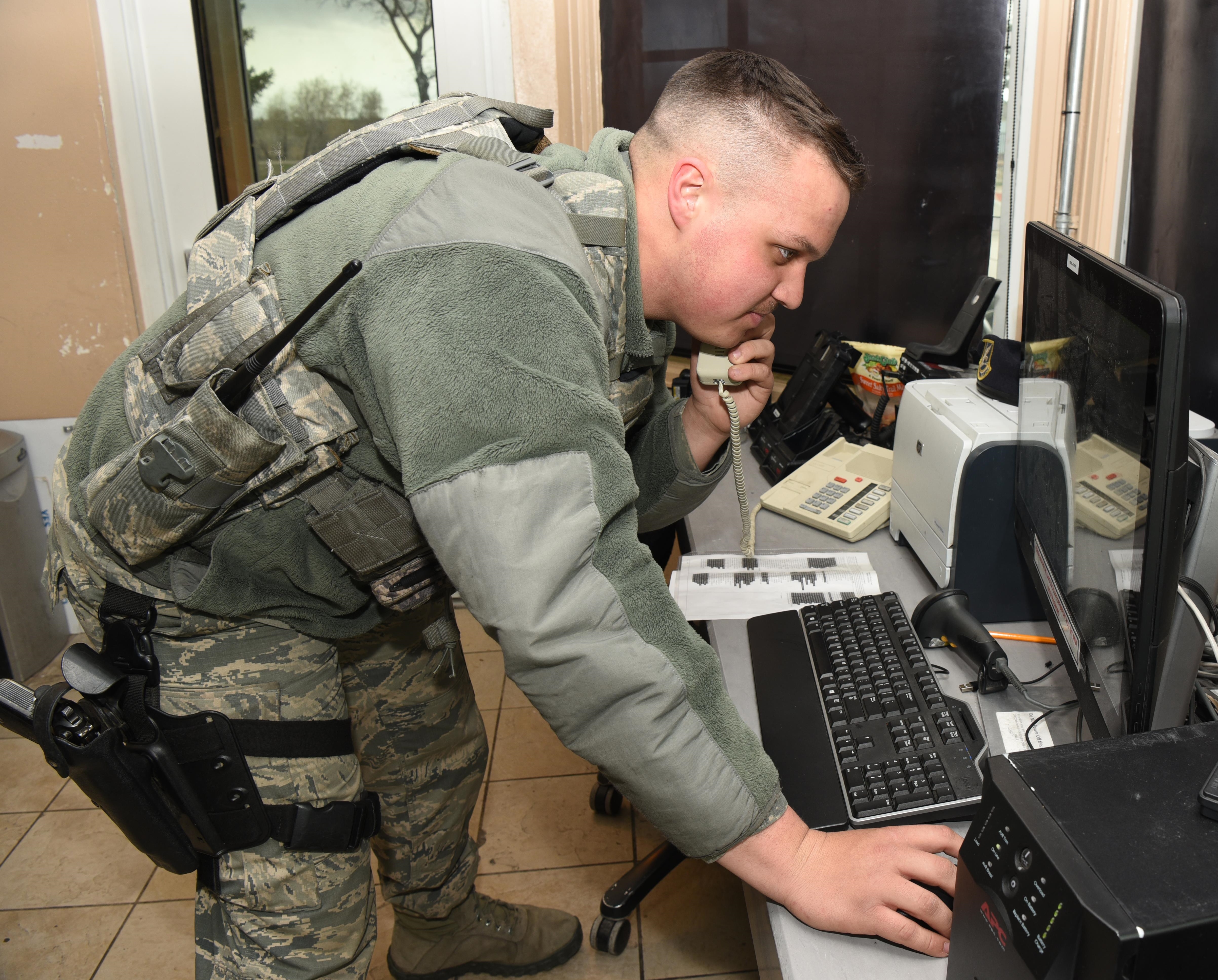
Airman 1st Class Ramon Cruz, 90th Security Forces Squadron installation entry controller, makes a phone call at F.E. Warren Air Force Base, Wyo., May 1, 2017. The gate guards have frequent contact with the law enforcement desk, which provides them with information and help to further defend the base. (U.S. Air Force photo by A1Cl Breanna Carter)
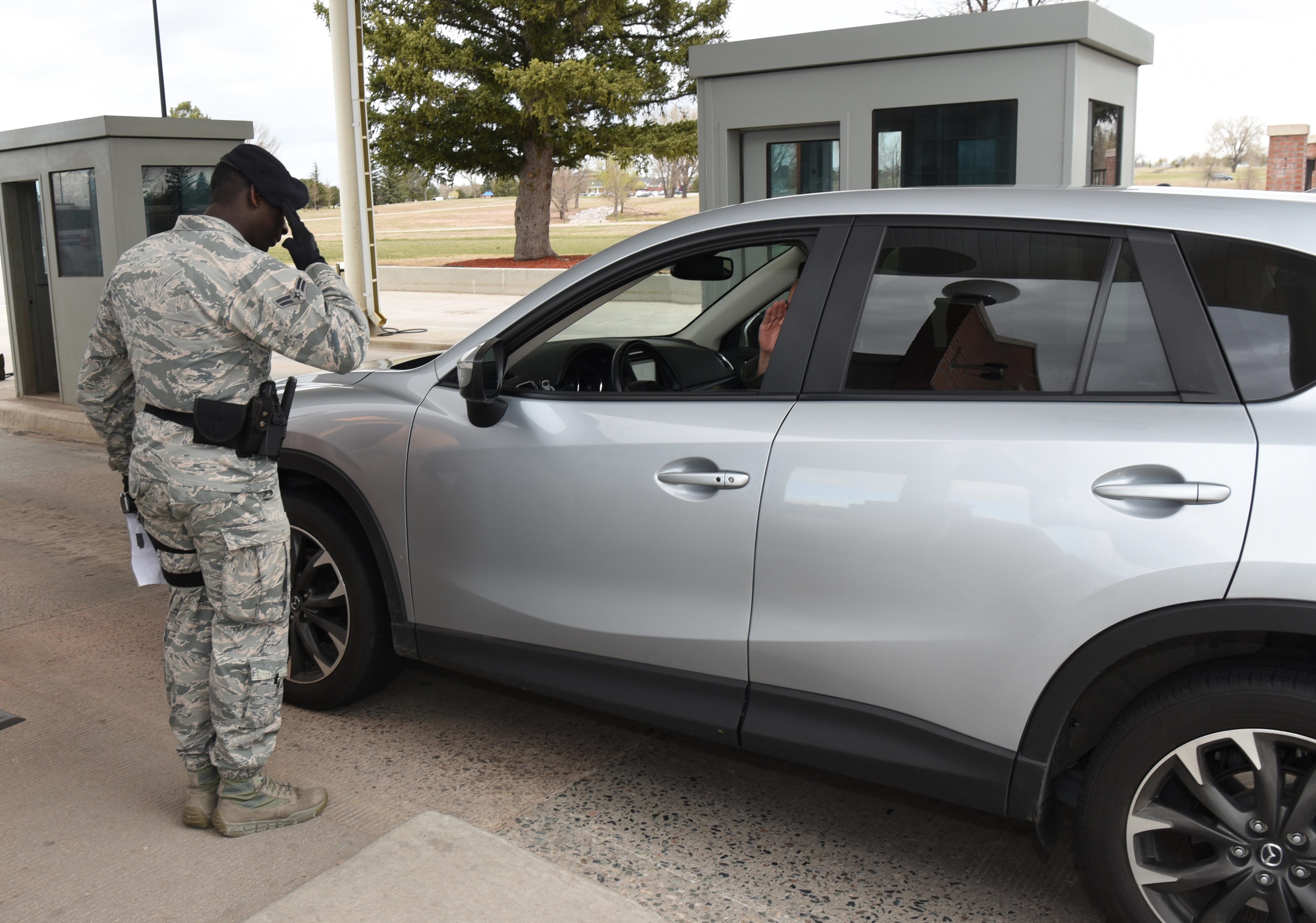
Airman 1st Class Zarquis Butler, 90th Security Forces Squadron installation entry controller, salutes an officer at F.E. Warren Air Force Base, Wyo., May 1, 2017. Defenders must render proper customs and courtesies while on shift. Defenders at the gate are the first line of defense for the installation. (U.S. Air Force photo by A1C Breanna Carter)
F.E. WARREN AIR FORCE BASE, WY
I wake up every morning, get ready and drive to the base for work. This is my every day routine and once I arrive to the base, I patiently wait in line to hand my ID to the gate guard. I then drive through without a second thought about the daily challenges these men and women have to overcome.
I recently had the opportunity to step back from my daily practices and see first-hand the routine of our defenders at the gate. It begins early in the morning, before the sun has begun to rise, at guard mount. This is pretty much a formation where defenders check their equipment, conduct roll call and receive their duty assignments.
After that, they’re ready to relieve those at the gate and begin their long shift.
“We’re on duty for at least 12 hours and we’re posted here about three times a week,” said Airman 1st Class Zarquis Butler, 90th Security Forces Squadron installation entry controller.
There are many challenges our defenders face at the gate, and if you’ve been at F.E. Warren long enough, then you know one of those challenges is weather. After about 45 minutes of standing at the gate my fingers were already numb and the wind in my face was intolerable, but our defenders were unbothered and set on maintaining their bearing and staying alert.
“The weather can be tough to deal with and the traffic gets backed up past the highway, but we try to keep a positive attitude,” Butler said. “We’re the first line of defense to the base and the first face that people see before entering, so knowing the importance of what we do is good motivation.”
One thing I quickly noticed is that people can be very upset about the time it takes to get through the gate.
“Sometimes people get mad at us because they feel we’re taking too long, but I have to remain calm and continue to go through my procedures,” Butler said. “I check IDs against a list of people that aren’t allowed on base or shouldn’t be driving. There are also times where we have to perform random vehicle inspections. It’s important that I don’t get distracted by those that are upset because my priority is the safety of this installation and its personnel.”
Though there are challenges, there are also good days according to Airman 1st Class Ramon Cruz, 90th SFS installation entry controller. It doesn’t take much to make their day.
“I’m a people person so I love being out here,” Cruz said. “There have been times where the command chief came out to help us and it makes you feel good to know leadership cares. There’s also times where people will drop off donuts, bagels, pizza and sometimes hot chocolate when it’s cold outside,” Cruz said. “It feels good to know people think about us.”
So there you have it. When you get used to driving through the gate, it’s easy to see our defenders simply as a checkpoint before getting to your destination, but try to keep in mind how essential they are to the mission and defending this base day in and day out.
BGen (ret) William R. Brooksher, 1930-2017
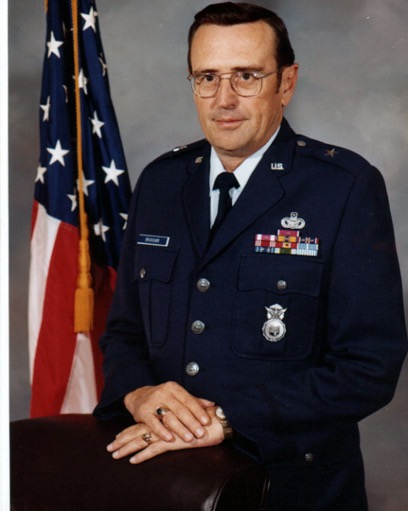
It is with sad hearts that we announce the passing of BGen William R. (Bill) Brooksher. BGen Brooksher served as the Chief of Security Police and Commander of the Air Force Office of Security Police from 1978 to 1981. Prior to that he was Director of Security and Law Enforcement for Strategic Air Command. He began his service in 1950 as an enlisted clerk typist. He received his commission through Officer Candidate School in 1956. After a short time in the personnel career field he entered the missile force as a Titan ICBM crew commander and continued through the ranks to colonel. He commanded Minuteman missile wings at Malmstrom Air Force Base, Montana, and Minot Air Force Base, North Dakota, before his assignment as the SAC/CSP. He was the driver behind the writing of the Security Forces Prayer which can be found on the Air Force Security Forces Association web site with this link. https://www.afsfaonline.com/index.php/about-us/history/33-history/41-security-forces-prayer
Bill was the first president of the Air Force Security Police Association. A Founding and Life Member, he played a significant role in shaping the Association. He and his lovely wife, Avil, regularly attended our annual meetings. His leadership made a permanent mark on our Association.
Bill continued throughout his life to be a supporter and encourager. His contributions to the career field and positive impact on all who knew him are his legacy.
Family only services are planned.
445 SFS Airman Honors Fellow SF Airmen With Memorial
By Stacy Vaughn, 445th Airlift Wing Public Affairs
A special memorial honoring the fallen men and women serving in security forces across the Air Force is proudly displayed in the 445th Security Forces Squadron. It was built by a 445th SFS Airmen as his away to pay tribute and to recognize the sacrifices of the 14 fallen heroes.
Staff Sgt. Dustin Ellison, 445th Security Forces Squadron SF craftsman, started working on the memorial March 2017. The display features the faces, names and dates the Airmen made the ultimate sacrifice. Words above the faces say, “Honoring those security forces members who have made the ultimate sacrifice in combat for their country.” Three lights above shine down, highlighting the images. In front of the display board is a pair of combat boots sitting with a rifle mounted in between and a security forces beret on top. Both an American and an Air Force flag sit on each side of the memorial.
“Many don’t understand, or realize the sacrifices that the men and women of the United States Air Force Security Forces actually make. It’s an understanding that few know and to have a memorial of the Defenders that have made that ultimate sacrifice, gives other members a visual remembrance of those sacrifices,” Ellison said.
Ellison said the memorial not only recognizes the current Defenders and the sacrifices that are made on a routine basis, but will also give new Defenders a better understanding of the sacrifices that other members of the security forces family have made.
One of the faces on the memorial is of Staff Sgt. Todd "TJ" Labraico, an Airman deployed to Afghanistan at the same time Ellison was serving there as a desk sergeant.
“I was in charge of dispatching the posts and patrols within my sector, as well as monitoring any suspicious activity. Although he was on a Reaper team and went outside the wire, I would hear the Reaper teams calling in over the radio for pre-authorizations to exit and enter through our vehicle entry control point. I didn’t personally know him, but when someone who you’re deployed with gives the ultimate sacrifice like TJ did, it feels as if you had a special brotherly bond just being in the same career field. It was a tough loss. Godspeed to his family for his sacrifice.”
Ellison has served in the military 11 years. Both of his grandfathers served, and he felt it was in his blood to serve, especially to serve as a Defender. He remarked that he couldn’t see himself in any other career field other than security forces.
“I’m honored to be a Defender, and it’s an honor to have a memorial like the one that stands at the 445th Security Forces Squadron. It’s a sacred piece, and I'm proud to have put this memorial together. I can only hope that we won’t have to add more to this short list of heroes.”
National Police Week is May 14-20, 2017. It’s an opportunity to pay special recognition to those law enforcement officers who have lost their lives in the line of duty for the safety and protection of others.
“On Your Side, Fighting For You.”
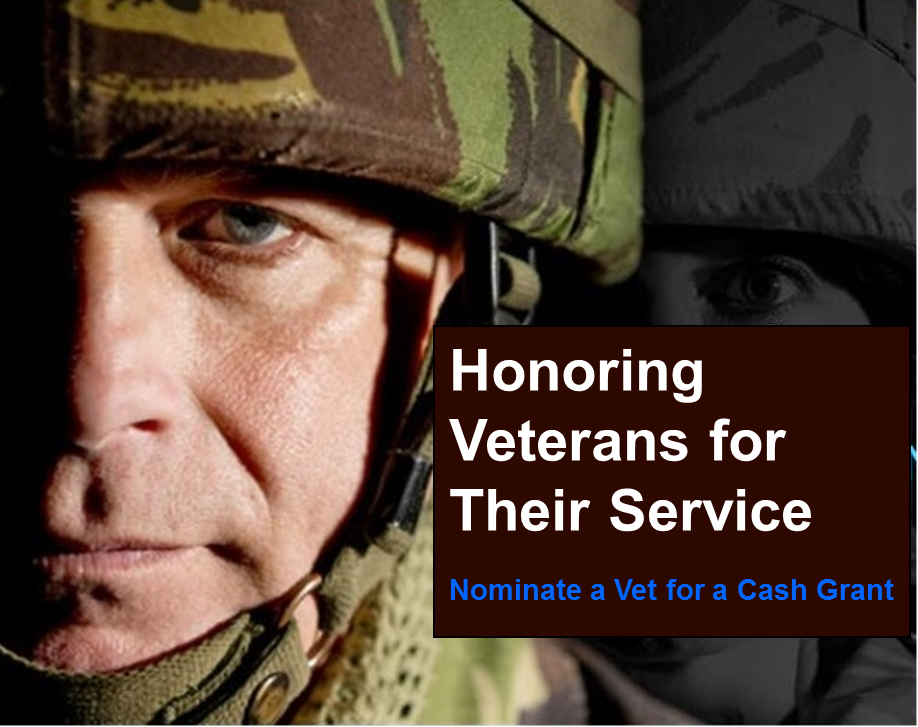
To recognize the sacrifices veterans have made for our country, the law firm of David Resnick & Associates is awarding cash grants to men and women who have served in the U.S. armed forces.
“On Your Side, Fighting For You.”
That’s the motto at David Resnick & Associates. It also applies to veterans. While our firm fights for injured victims in the courtroom and at the negotiating table, veterans were on our country’s side, fighting to protect all of us. We believe it’s time to honor deserving vets.
David Resnick & Associates is holding an essay competition that will determine the winners of $4,000 in total cash awards. Check out the details below to find out more about the competition and how to enter.
Nominate a veteran within our legion, or nominate yourself for a cash grant. David Resnick and Associates is now opening up applications for the first "Honoring Veterans For Their Service" cash grant competition. Applicants are required to submit a 600-word essay that discusses why the nominated veteran (a peer of yourself) is deserving of the award amount.
Three winners will take home cash prizes- first place will receive $2,500, second place $1,000 followed by a third place price of $500. All applications must be received by July 1st via email submission to the address listed on the contest page: https://www.injuryclaimnyclaw.com/veterans-grant-contest/
Page 34 of 50



